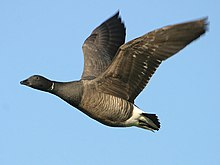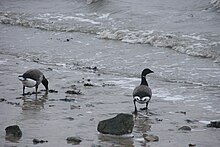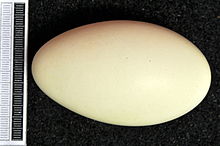Brent Goose
| Brent Goose | ||||||||||||
|---|---|---|---|---|---|---|---|---|---|---|---|---|

Brent goose ( Branta bernicla bernicla ) |
||||||||||||
| Systematics | ||||||||||||
|
||||||||||||
| Scientific name | ||||||||||||
| Branta bernicla | ||||||||||||
| ( Linnaeus , 1758) |
The Brent Goose ( Branta bernicla ) is a small, sociable species of the genus sea geese ( Branta ) of the family of ducks (Anatidae). It is the smallest and darkest of the sea geese, which, in addition to the brent goose , include the barnacle goose , the red necked goose and the Canada goose . Their breeding area is the arctic cold desert and arctic tundra of Eurasia and North America. In Germany she is a winter guest on the North Sea coast . One of the peculiarities of the Brent goose is its close connection to the sea and the sea coast during migration and wintering.
As with the wood pigeon , the German name of the goose refers to the white neck ring. Occasionally the goose is also referred to as the red goose , which is derived from the dull sounding flight call.
Subspecies
The Brent Goose is divided into three subspecies:
- The dark-bellied brent goose ( Branta bernicla bernicla ) is the so-called nominate form, which was first scientifically described by Carl von Linné . It is dark slate gray and has small white bands on the sides of the neck.
- The black-bellied brent goose ( Branta bernicla nigricans ) is sometimes referred to as the Pacific brent goose . Their body plumage has clear black tones and a wide, almost closed white neck ring.
- The light-bellied brent goose ( Branta bernicla hrota ) has a lightened, brownish body plumage with narrow white collars.
Appearance
Brent geese are black-gray with a gray-brown back and black and white banded flanks. The adult birds have narrow white crescent spots on their necks that vary in size depending on the subspecies. The upper and lower tail-coverts as well as the belly are white. Depending on the subspecies, the breast color is either lighter gray from the black front breast or a darker gray and gradually merges into the dark breast plumage. The beak, legs and wings are colored black. The wingspan is 110 to 120 centimeters, the weight about 1 to 1.5 kilograms. In general, the males are about 150 grams heavier than the females.
The chicks are feathered gray-brown on the upper side in their down dress, the head and neck sides as well as the belly are light gray.
voice
The Brent Goose is not a very fiery goose. Her voice can mostly be heard when she is in groups or when she changes location. When alarmed, a deep, dull and nasal “ rott, rott, rott ” or “ rott rorott ” can be heard. This call can also be throaty: " rronk ". During the flight it emits a short and hard “ ack ” or “ ek ”. In grazing troops, they keep in contact with each other by constant, soft “ bi bi bi ” calls. Aggressive Brent geese make hissing noises.
distribution
The Brent Goose breeds in Arctic Eurasia and the Arctic of North America. Their area of distribution is therefore also called circumpolar Holarctic. The July isotherms of 1 degree Celsius in the north and 7 degrees Celsius in the south are the limits of distribution.
The individual subspecies can be found in the following regions in summer:
- the dark-bellied brent goose ( Branta bernicla bernicla ) in northern Siberia between about 65 and 80 degrees of latitude,
- the black-bellied brent goose ( Branta bernicla nigricans ) from Eastern Siberia to the east to northwest Canada, from about 160 to 80 degrees longitude and
- the hellbäuchige Brent Goose ( Branta bernicla hrota ) in the intervening areas of western Canada, northern Greenland, Spitsbergen and Franz Josef Land .

The winter quarters are
- in the dark-bellied brent goose ( Branta bernicla bernicla ) on the European Atlantic and North Sea coasts from southern France to Jutland and the British Isles . In Germany, Brent geese can be found regularly in the winter months and in larger groups in the Wadden Sea of the North Sea . They overwinter in small numbers in the Wismar Bay of the Baltic Sea. The Brent Goose is very rarely found inland.
- in the black-bellied brent goose ( Branta bernicla nigricans ) on the Pacific coast from British Columbia to Baja California, only occasionally on the coasts of Japan and China , very rarely in Europe and
- the light-bellied brent goose ( Branta bernicla hrota ) on the coast of southeast England.
Way of life
The Brent Goose is a migratory bird that migrates south in winter. When they are on their migration, Brent geese do not form the characteristic V-formation, they fly quickly, but not in formation. The migration routes of Brent geese are not genetically determined, but are in different subpopulations handed down . In addition to the train to the wintering quarters, there is a so-called moulting procession of the non-breeding animals to certain moulting sites, especially on the Taimyr Peninsula . Apart from the mating and breeding season, Brent geese live in large flocks. Brent geese are usually very loyalty to their partners, but they mate again when the partner is lost.
The breeding starts immediately after arriving in the breeding areas in June. Brent geese breed in colonies in the coastal arctic tundra. The light-bellied species often breeds on smaller islands off the coast. Brent geese breed in small colonies and build their nests on dry, higher-lying sections of the tundra. It is not uncommon for the colonies to be located in the immediate vicinity of birds of prey and great gulls. However, this bond is not as pronounced as in the imperial goose . Usually three to five eggs are laid. The young hatch after 24 to 26 days, and they only take about 40 days to raise. As soon as the newly hatched chicks have dried off, the families switch to lakes, rivers and estuary areas in the breeding area. The couple bond loosens during this time. The gander separate themselves from the families and form independent moulting groups. The full moult begins when the chicks hatch. The change of wings, which begins in mid-July in adult birds, lasts until around mid-August. This is the time when the young geese also fledge.
nutrition
Brent geese live on short grass, herbs, moss and lichen vegetation as well as on marine plants. When foraging for food, the geese are mainly tied to the flat coasts of the Wadden Sea. Their foraging takes place on seagrass, green algae and andel grass areas. In winter they also use the grass and winter crops of the inland regions. In the Schleswig-Holstein Wadden Sea, farmers in the foreshore of the coast and on the Halligen feared the marigold goose moving through, although they are being compensated for the damage caused today. So the geese invaded limited areas of land, where they ate the vegetation down to the length of an English lawn in a very short time , preferring the Andel grass of the salt marshes.
Inventory development
Total inventory development
After large stocks of seaweed had died by 1932 due to an infestation with the unicellular slime mold Labyrinthula , the population in the European winter migration areas fell to around 10 to 25 percent of the population figures at the beginning of the 20th century. In addition to the loss of winter food, intensified hunting and amelioration work on the wintering sites also contributed to the decline in the population. According to various ornithological publications, Soviet prisoners in Siberia are said to have rounded up the brent geese by the thousands during the moult - in which the birds are unable to fly - and then ate them along with the eggs for lack of other food sources. With the end of the gulag system , the Brent goose population was able to recover. Protective measures, including a hunting ban, contributed to the population's recovery. The remaining populations of Brent geese also switched to plants from the Salzhaffwiesen in their diet. In Western Europe, the resting places of the Brent goose are protected in order to optimize the energy balance of the birds by avoiding disturbances .
Stock development in relation to the lemming population
The chances of survival of the Brent geese chicks and thus the total stock of Brent geese depends largely on the strongly fluctuating lemming population in the goose's breeding areas. These rodents are widespread in the Arctic and are important prey for skuas , birds of prey and foxes that also prey on goslings. In years with high lemming populations, the birds lose their relevance as food and have good reproductive success. In contrast, in years after the collapse of the lemmings population. Now the small number of lemmings faces many predators and so every other prey animal becomes important. The predators switch their foraging to eggs, chicks and adult birds. The consequences have long been visible in Western Europe as well: years of high breeding success for geese have always alternated with years in which they arrive in the wintering area with few young birds or almost no offspring.
Development of the individual subspecies
- The population of the dark-bellied brent goose ( Branta bernicla bernicla ) rose from around 20,000 around 1955 to around 250,000 to 300,000 at the end of the 20th century.
- The population of the black-bellied brent goose ( Branta bernicla nigricans ) sank from a few thousand animals around 1900 to a few hundred in the second half of the 20th century, but is again around 4,000 animals at the turn of the millennium.
- The population of the light-bellied brent goose ( Branta bernicla hrota ) is difficult to quantify. It has dropped from a total of around 10,000 animals since 1900, then has recovered again since the middle of the century and was again around 25,000 animals in 2003.
The IUCN puts the total population of the species at 570,000 animals.
protection
In order to bring the protection of the Brent geese closer to a wider public, in Schleswig-Holstein u. a. NABU , Wadden Sea Protection Station , WWF and National Park Service jointly organize the Ringelganstage on the North Frisian Halligen in the Schleswig-Holstein Wadden Sea National Park .
literature
- Hans-Heiner Bergmann , Helmut Kruckenberg & Volkhard Wille: Wild geese - travelers between wilderness and pastureland. G. Braun Verlag, Karlsruhe 2006.
- J. Madsen, G. Cracknell & Tony Fox (1999): Goose Populations of the Western Palearctic, Wetlands International, Wageningen.
- Erich Rutschke: Wild geese: way of life - protection - use. Parey, Berlin, 1997, ISBN 3-8263-8478-4
- Hans-Heiner Bergmann, Martin Stock & Birgit ten Thoren (1994): Brent geese - arctic guests on our coasts. - Aula, Wiebelsheim
- Detlev Singer, The Birds of Central Europe, Kosmos Nature Guide
- Steve Madge, Hilary Burn (1989): Water fowl, Parey Verlag, Hamburg / Berlin
- Sawwa M. Uspenski : Die Wildgänse Nordeurasiens , Westarp Wissenschaften-Verlagsgesellschaft, Hohenwarsleben 2003, reprint of the 1st edition from 1965, ISBN 3-89432-756-1
Web links
- Branta bernicla in the endangered Red List species the IUCN 2008. Posted by: BirdLife International, 2008. Accessed January 31 of 2009.
- Videos, photos and sound recordings of Branta bernicla in the Internet Bird Collection
- Brent goose feathers on Vogelfedern.de
Individual evidence
- ↑ Hans-Heiner Bergmann; Hans-Wolfgang Helb; Sabine Baumann; The voices of the birds of Europe - 474 bird portraits with 914 calls and chants on 2,200 sonograms , Aula-Verlag, Wiesbaden 2008, ISBN 978-3-89104-710-1 , p. 37
- ↑ Sawwa M. Uspenski: Die Wildgänse Nordeurasiens , p. 29
- ↑ Klaus Janke, Bruno P. Kremer: The Watt. Habitat, animals and plants . Franckh, Stuttgart 1990, ISBN 3-440-06035-7 , pp. 95 .
- ↑ Sawwa M. Uspenski: Die Wildgänse Nordeurasiens , p. 28
- ↑ Harald Asmus, Ragnhild Asmus: Neptune's swaying gardens - seagrass meadows are oases on sandy coasts . In: Gotthilf Hempel, Irmtraut Hempel, Siegrid Schiel (eds.): Fascination Marine Research . HM Hauschild, Bremen 2006, ISBN 3-89757-310-5 , p. 218 .
- ↑ Hans-Heiner Bergmann, 1939-: Wild geese travelers between wilderness and pasture . Karlsruhe, ISBN 978-3-7650-8321-1 .



